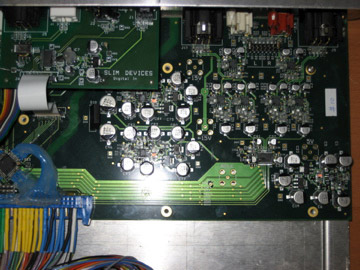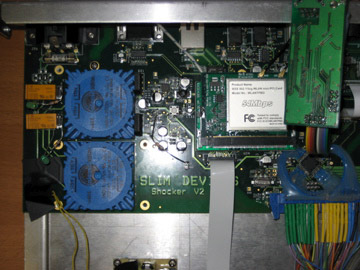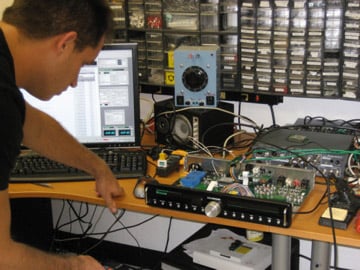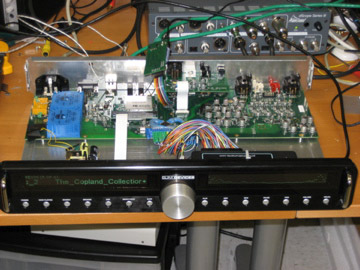Original URL: https://www.theregister.com/2006/08/16/preview_slim_devices_transporter/
Slim Devices Transporter high-end digital audio player
Audiophile device transports music to a new level?
Posted in Personal Tech, 16th August 2006 12:01 GMT
Exclusive Preview Mountain View, California is the home of start-ups. Turn any corner and it's likely there'll be a name you recognise. Some have grown into huge companies, and some, like Netscape, have disappeared, recalled only by the boards that used to display their logos. Turning down what looks like a residential street, there's a small building that turns out to be the home of Slim Devices, best known as a maker of consumer-friendly music streamers. But now it's chasing the big time with a device for the audiophile arena...
Slim Devices' players have constantly been improved over time, with the latest incarnation being the Squeezebox 3 - you can read Reg Hardware's full review here. As a sub-$300 unit, the Squeezebox pretty well dominates its market and it does a very good job. However, there have been criticisms, the main one being that it's not an audiophile product.

Enter the Transporter, announced in July as Slim Devices' foray into the very high-end market. It's not cheap - expect to pay around $2,000 when it launches later this year. Availability is anticipated for mid to late September.
Slim Devices has a clever approach to music streaming: put the intelligence into the music server software - it's called SlimServer - so the hardware only needs to decode music streams and drive the displays. That's not to say the player lacks brains. There is some intelligence in the player and that's where Slim Devices does its magic - and maintains its secrets. This code is tightly controlled by Slim Devices.
Other companies wouldn't dream of pre-announcing a product so early. But Slim Devices is in strange position: it has to. While the core functionality delivered by SlimServer are driven by Slim Devices, the code's open source so much of the development work is carried out by the community who make the client do interesting things apart from just stream music. In order to support the new features of Transporter, the server needs to be updated, and to do that the software development community needs to know about the new hardware well in advance of it actually shipping.

Even the internals of the Transporter have been influenced by dedicated members of the community. Some have been hired to implement various pieces of hardware or the software.
So what's new? The main improvement over the Squeezebox is the a audio DAC (Digital to Analogue Converter) which is very high quality using a delta-sigma conversion technique. The unit has optical, co-ax, BNC and XLR digital inputs and outputs. Other devices, such as a CD player, can be connected to the digital inputs and use the Transporter's high-quality DACs to convert the audio rather then the potentially poorer ones in the player itself. Analogue output is available from phono and balanced XLR connections.

There's an external clock input, however the internal oscillators are extremely accurate so clocking the unit internally can actually produce better results than using the clock signal from an external source, Slim Devices maintains.
The power supply has also been completely redesigned and uses linear units for the audio side of things and a regular switch-mode power supply to drive the digital circuitry, including the displays. One problem with linear (transformer) supplies is that they only operate at a fixed input voltage so switching between US 110V and European 220V is usually a manual operation - which tends to mean fried systems or at least blown fuses. Slim Devices gets around this by initially connecting the linear supply to the 220V inputs and then clever circuitry driven by the switch-mode supply monitors the output voltage - if it's too low then it switches the input mode of the linear supply to 110V. As a result, nothing blows and the Transporter will work anywhere when plugged in.

The remote control is also new. It's smaller and more stylish than the Squeezebox's remote and complements the new player's aesthetics nicely. The control also feels much more comfortable in the hand than its predecessor and other remotes do.

As can be seen from the photos, it's all there and (almost) working. The music quality is vastly improved when played through a sensible, audiophile system. The twin 320 x 32 vacuum fluorescent displays - the same as the Squeezebox's screen - make navigation very easy while allowing for special effects like two single-channel VU meters, one for the left speaker, the other for the right.

The unit has built-in 802.11b/g Wi-Fi and 10/100Mbps Ethernet. It will decode and play streamed WAV, AIFF, MP3, WMA and FLAC files, with other formats supported by on-the-fly decoders running on the computer hosting the music. As with the Squeezebox, there's no support for WMA DRM files or songs downloaded from Apple's iTunes Music Store.

There are still a few bugs but these are being worked on, Slim Devices said. The remaining issues are mainly cosmetic - though it is still possible to crash the unit. The audio quality is constantly being improved along with usability, but it sounded pretty good when I sampled it.
Playing audio streams which were encoded in a lossless format - WAV, FLAC and Apple - shows the transparency of the Transporter. Any sounds in the original recordings are faithfully reproduced. Playing badly encoded or low bit-rate MP3s shows just how badly encoded they are. This is an audiophile system and demands a high quality amplifier and speaker system to make the most of it - if it's going to be used with an iPod-type speaker system get a Squeezebox instead.
Though the Transporter does have a digital output stage, it's almost a waste as the DACs and analogue output are so well engineered and such a huge amount of effort has been put in to get that sounding just right. The digital outputs are exceptionally clean and will probably outshine any other digital device in a home set-up.
Verdict
Slim Devices' Transporter looks good and sounds great. It's not for everyone - if your digital music collection consists entirely of 128Kbps MP3s, you're going to hear why audiophiles prefer lossless music formats. But if you're the proud owner of a hi-fi that cost more than a small car and you're ready to archive your music collection to computer, Transporter should be at the top of your list of equipment to audition. ®